Java負載平衡演算法的作用是什麼?
- PHPz轉載
- 2023-05-07 14:37:18866瀏覽
前言
負載平衡在Java領域中有著廣泛深入的應用,不管是大名鼎鼎的nginx,或是微服務治理元件如dubbo,feign等,負載平衡的演算法在其中都有實際的使用
負載平衡的核心思想在於其底層的演算法思想,例如大家熟知的演算法有輪詢,隨機,最小連接,加權輪詢等,在現實中不管怎麼配置,都離不開其演算法的核心原理,以下將結合實際程式碼對常用的負載平衡演算法做一些全面的總結。
輪詢演算法
輪詢即排好隊,一個接一個的輪著來。從資料結構上,有一個環狀的節點,節點上面佈滿了伺服器,伺服器之間首尾相連,帶有順序性。當請求過來的時候,從某個節點的伺服器開始回應,那麼下一次請求再來,就依次由後面的伺服器回應,由此繼續
按照這個描述,我們很容易聯想到,可以使用一個雙向(雙端)鍊錶的資料結構來模擬實作這個演算法
1、定義一個server類,用來識別伺服器中的鍊錶節點
class Server {
Server prev;
Server next;
String name;
public Server(String name) {
this.name = name;
}
}2、核心程式碼
/**
* 轮询
*/
public class RData {
private static Logger logger = LoggerFactory.getLogger(RData.class);
//标识当前服务节点,每次请求过来时,返回的是current节点
private Server current;
public RData(String serverName) {
logger.info("init servers : " + serverName);
String[] names = serverName.split(",");
for (int i = 0; i < names.length; i++) {
Server server = new Server(names[i]);
//当前为空,说明首次创建
if (current == null) {
//current就指向新创建server
this.current = server;
//同时,server的前后均指向自己
current.prev = current;
current.next = current;
} else {
//说明已经存在机器了,则按照双向链表的功能,进行节点添加
addServer(names[i]);
}
}
}
//添加机器节点
private void addServer(String serverName) {
logger.info("add new server : " + serverName);
Server server = new Server(serverName);
Server next = this.current.next;
//在当前节点后插入新节点
this.current.next = server;
server.prev = this.current;
//由于是双向链表,修改下一节点的prev指针
server.next = next;
next.prev = server;
}
//机器节点移除,修改节点的指向即可
private void removeServer() {
logger.info("remove current = " + current.name);
this.current.prev.next = this.current.next;
this.current.next.prev = this.current.prev;
this.current = current.next;
}
//请求。由当前节点处理
private void request() {
logger.info("handle server is : " + this.current.name);
this.current = current.next;
}
public static void main(String[] args) throws Exception {
//初始化两台机器
RData rr = new RData("192.168.10.0,192.168.10.1");
new Thread(new Runnable() {
@Override
public void run() {
while (true) {
try {
Thread.sleep(500);
} catch (InterruptedException e) {
e.printStackTrace();
}
rr.request();
}
}
}).start();
//3s后,3号机器加入清单
Thread.currentThread().sleep(2000);
rr.addServer("192.168.10.3");
//3s后,当前服务节点被移除
Thread.currentThread().sleep(3000);
rr.removeServer();
}
}結合註解對程式碼進行理解,這段程式碼解釋開來就是檢視雙端鍊錶的底層能力,操作鍊錶結構時,最重要的就是要搞清在節點的加入和移除時,理清節點的前後指向,然後再理解這段程式碼時就沒有難度了,下面運行下程式

輪詢演算法優缺點小結
實作簡單,機器列表可自由加減,節點尋找時間複雜度為o(1)
無法針對節點做偏向性自訂處理,節點處理能力強弱無法做區分對待,例如某些處理能力強配置高的伺服器更希望承擔更多的請求這個就做不到
隨機演算法
從可提供的伺服器清單中隨機取一個提供回應。
既然是隨機存取的場景,很容易想到使用陣列可以更有效率的透過下標完成隨機讀取,這個演算法的模擬比較簡單,下面直接上程式碼
/**
* 随机
*/
public class RandomMath {
private static List<String> ips;
public RandomMath(String nodeNames) {
System.out.println("init servers : " + nodeNames);
String[] nodes = nodeNames.split(",");
//初始化服务器列表,长度取机器数
ips = new ArrayList<>(nodes.length);
for (String node : nodes) {
ips.add(node);
}
}
//请求处理
public void request() {
Random ra = new Random();
int i = ra.nextInt(ips.size());
System.out.println("the handle server is :" + ips.get(i));
}
//添加节点,注意,添加节点可能会造成内部数组扩容
void addnode(String nodeName) {
System.out.println("add new node : " + nodeName);
ips.add(nodeName);
}
//移除
void remove(String nodeName) {
System.out.println("remove node is: " + nodeName);
ips.remove(nodeName);
}
public static void main(String[] args) throws Exception {
RandomMath rd = new RandomMath("192.168.10.1,192.168.10.2,192.168.10.3");
//使用一个线程,模拟不间断的请求
new Thread(new Runnable() {
@Override
public void run() {
while (true) {
try {
Thread.sleep(1000);
} catch (InterruptedException e) {
e.printStackTrace();
}
rd.request();
}
}
}).start();
//间隔3秒之后,添加一台新的机器
Thread.currentThread().sleep(3000);
rd.addnode("192.168.10.4");
//3s后,当前服务节点被移除
Thread.currentThread().sleep(3000);
rd.remove("192.168.10.2");
}
}執行程式碼觀察結果:
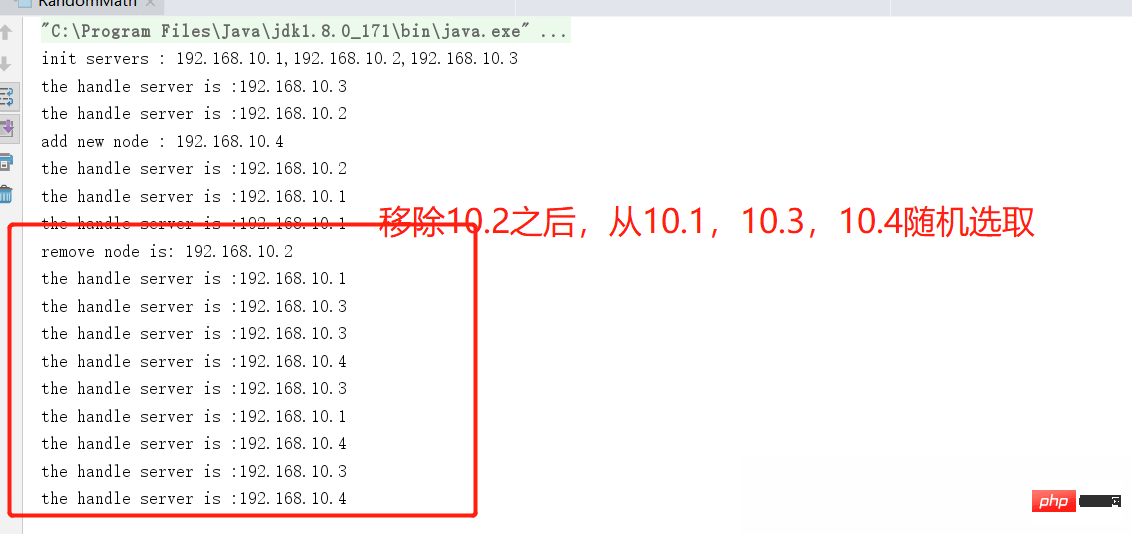
隨機演算法小結
隨機演算法簡單高效
適合在一個伺服器叢集中,各個機器配置差不多的情況,和輪詢一樣,無法根據各個伺服器本身的配置做一些定向的區分對待
#加權隨機演算法
在隨機選擇的基礎上,機器仍然是被隨機被篩選,但是做一組加權值,根據權值不同,機器列表中的各個機器被選中的機率不同,從這個角度理解,可認為隨機是一種等權值的特殊情況
設計思路依然相同,只是每個機器需要根據權值大小,產生不同數量的節點,節點排隊後,隨機取得。這裡的資料結構主要涉及到隨機的讀取,所以優選為數組
/**
* 加权随机
*/
public class WeightRandom {
ArrayList<String> list;
public WeightRandom(String nodes) {
String[] ns = nodes.split(",");
list = new ArrayList<>();
for (String n : ns) {
String[] n1 = n.split(":");
int weight = Integer.valueOf(n1[1]);
for (int i = 0; i < weight; i++) {
list.add(n1[0]);
}
}
}
public void request() {
//下标,随机数,注意因子
int i = new Random().nextInt(list.size());
System.out.println("the handle server is : " + list.get(i));
}
public static void main(String[] args) throws Exception{
WeightRandom wr = new WeightRandom("192.168.10.1:2,192.168.10.2:1");
for (int i = 0; i < 9; i++) {
Thread.sleep(2000);
wr.request();
}
}
}
#我們不妨將10.1的權重值再調的大點,例如調為3,再運行一下,這個效果就更明顯了

加權隨機演算法小結
#為隨機演算法的升級與最佳化
一定程度上解決了伺服器節點偏向問題,可以透過指定權重來提升某個機器的偏向
加權輪詢演算法
在前面的輪詢演算法中我們看到,輪詢只是機械的旋轉不斷在雙向鍊錶中進行移動,而加權輪詢則彌補了所有機器被一視同仁的缺點。在輪詢的基礎上,伺服器初始化時,各個機器攜帶一個權重值
加權輪詢的演算法思想不是很好理解,下面我以一個圖進行說明:
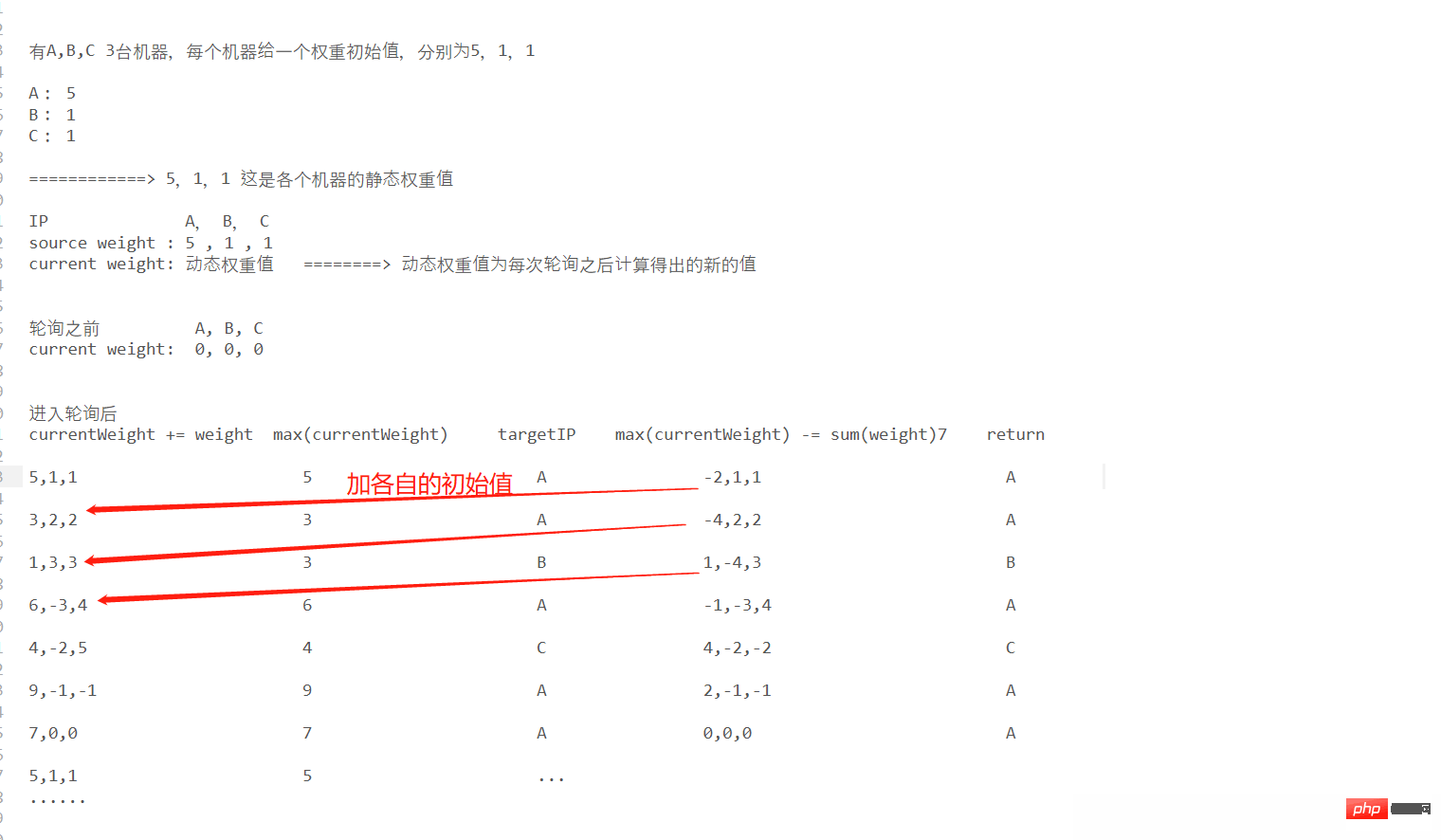


加權輪詢演算法的初衷是希望透過這樣一套演算法保證整體的請求平滑性,從上圖中也可以發現,經過幾輪的循環之後,由可以回到最初的結果,而且在某一個輪詢中,不同機器根據權重值的不同,請求被讀取的概率也會不同
实现思路和轮询差不多,整体仍然是链表结构,不同的是,每个具体的节点需加上权重值属性
1、节点属性类
class NodeServer {
int weight;
int currentWeight;
String ip;
public NodeServer(String ip, int weight) {
this.ip = ip;
this.weight = weight;
this.currentWeight = 0;
}
@Override
public String toString() {
return String.valueOf(currentWeight);
}
}2、核心代码
/**
* 加权轮询
*/
public class WeightRDD {
//所有机器节点列表
ArrayList<NodeServer> list;
//总权重
int total;
//机器节点初始化 , 格式:a#4,b#2,c#1,实际操作时可根据自己业务定制
public WeightRDD(String nodes) {
String[] ns = nodes.split(",");
list = new ArrayList<>(ns.length);
for (String n : ns) {
String[] n1 = n.split("#");
int weight = Integer.valueOf(n1[1]);
list.add(new NodeServer(n1[0], weight));
total += weight;
}
}
public NodeServer getCurrent() {
for (NodeServer node : list) {
node.currentWeight += node.weight;
}
NodeServer current = list.get(0);
int i = 0;
//从列表中获取当前的currentWeight最大的那个作为待响应的节点
for (NodeServer node : list) {
if (node.currentWeight > i) {
i = node.currentWeight;
current = node;
}
}
return current;
}
//请求,每次得到请求的节点之后,需要对当前的节点的currentWeight值减去 sumWeight
public void request() {
NodeServer node = this.getCurrent();
System.out.print(list.toString() + "‐‐‐");
System.out.print(node.ip + "‐‐‐");
node.currentWeight -= total;
System.out.println(list);
}
public static void main(String[] args) throws Exception {
WeightRDD wrr = new WeightRDD("192.168.10.1#4,192.168.10.2#2,192.168.10.3#1");
//7次执行请求,观察结果
for (int i = 0; i < 7; i++) {
Thread.currentThread().sleep(2000);
wrr.request();
}
}
}从打印输出结果来看,也是符合预期效果的,具有更大权重的机器,在轮询中被请求到的可能性更大

源地址hash算法
即对当前访问的ip地址做一个hash值,相同的key将会被路由到同一台机器去。常见于分布式集群环境下,用户登录 时的请求路由和会话保持
源地址hash算法可以有效解决在跨地域机器部署情况下请求响应的问题,这一特点使得源地址hash算法具有某些特殊的应用场景
该算法的核心逻辑是需要自定义一个能结合实际业务场景的hash算法,从而确保请求能够尽可能达到源IP机器进行处理
源地址hash算法的实现比较简单,下面直接上代码
/**
* 源地址请求hash
*/
public class SourceHash {
private static List<String> ips;
//节点初始化
public SourceHash(String nodeNames) {
System.out.println("init list : " + nodeNames);
String[] nodes = nodeNames.split(",");
ips = new ArrayList<>(nodes.length);
for (String node : nodes) {
ips.add(node);
}
}
//添加节点
void addnode(String nodeName) {
System.out.println("add new node : " + nodeName);
ips.add(nodeName);
}
//移除节点
void remove(String nodeName) {
System.out.println("remove one node : " + nodeName);
ips.remove(nodeName);
}
//ip进行hash
private int hash(String ip) {
int last = Integer.valueOf(ip.substring(ip.lastIndexOf(".") + 1, ip.length()));
return last % ips.size();
}
//请求模拟
void request(String ip) {
int i = hash(ip);
System.out.println("req ip : " + ip + "‐‐>" + ips.get(i));
}
public static void main(String[] args) throws Exception {
SourceHash hash = new SourceHash("192.168.10.1,192.168.10.2");
for (int i = 1; i < 10; i++) {
String ip = "192.168.1." + i;
hash.request(ip);
}
Thread.sleep(3000);
System.out.println();
hash.addnode("192.168.10.3");
for (int i = 1; i < 10; i++) {
String ip = "192.168.1." + i;
hash.request(ip);
}
Thread.sleep(3000);
System.out.println();
hash.remove("192.168.10.1");
for (int i = 1; i < 10; i++) {
String ip = "192.168.1." + i;
hash.request(ip);
}
}
}请关注核心的方法 hash(),我们模拟9个随机请求的IP,下面运行下这段程序,观察输出结果
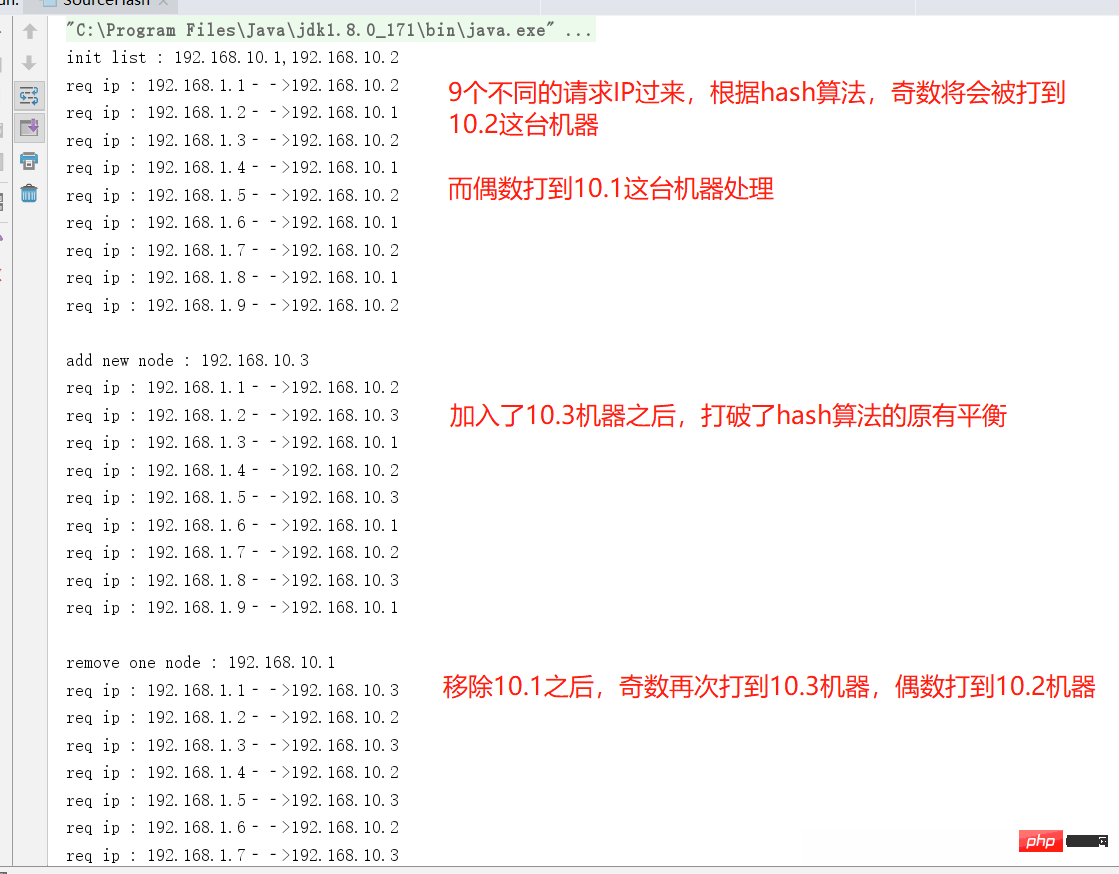
源地址hash算法小结
可以有效匹配同一个源IP从而定向到特定的机器处理
如果hash算法不够合理,可能造成集群中某些机器压力非常大
未能很好的解决新节点加入之后打破原来的请求平衡(一致性hash可解决)
最小请求数算法
即通过统计当前机器的请求连接数,选择当前连接数最少的机器去响应新请求。前面的各种算法是基于请求的维度,而最小 连接数则是站在机器的连接数量维度
从描述来看,实现这种算法需要定义一个链接表记录机器的节点IP,和机器连接数量的计数器
而为了比较并选择出最小的连接数的机器,内部采用最小堆做排序处理,请求响应时取堆顶节点即是 最小连接数(可以参考最小顶堆算法)
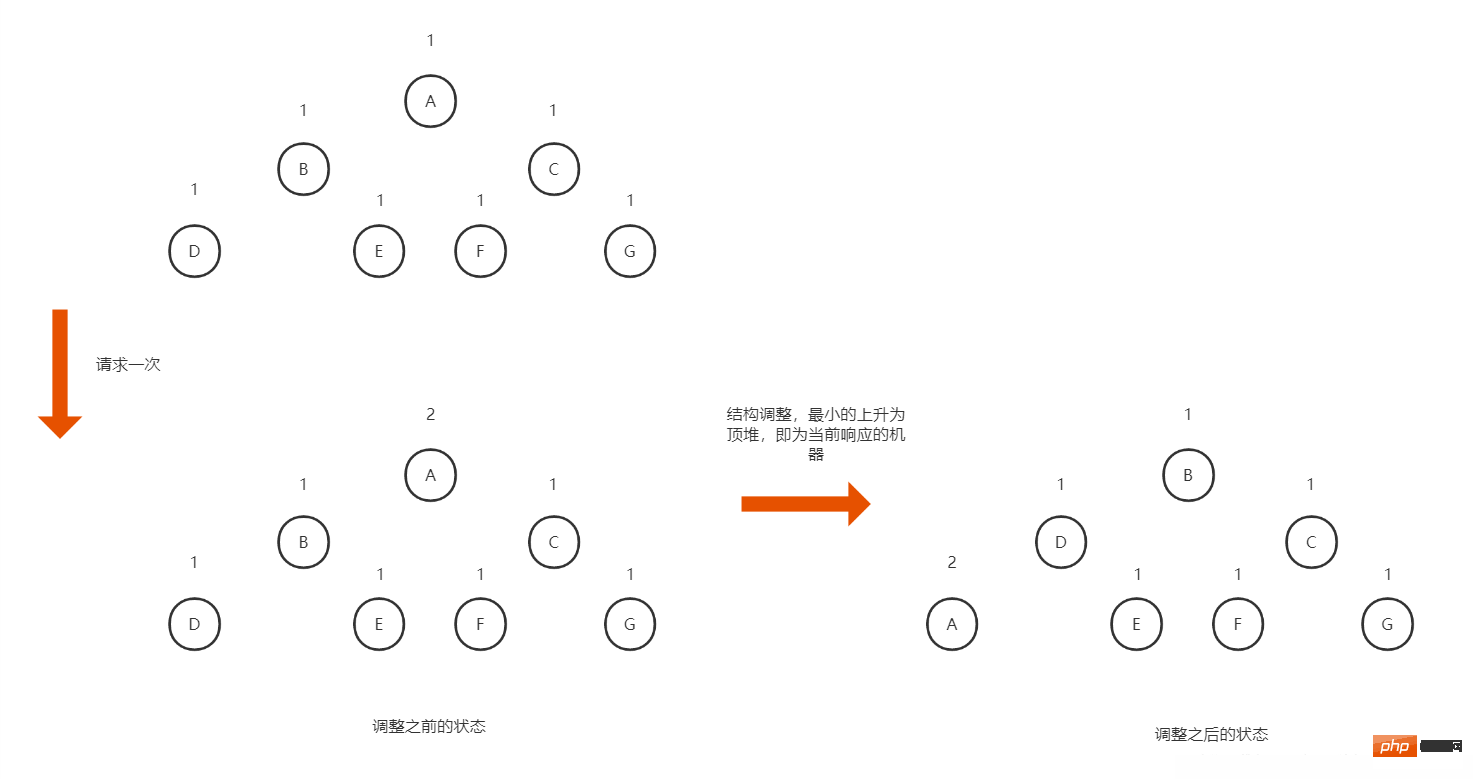
如图所示,所有机器列表按照类二叉树的结构进行组装,组装的依据按照不同节点的访问次数,某次请求过来时,选择堆顶的元素(待响应的机器)返回,然后堆顶机器的请求数量加1,然后通过算法将这个堆顶的元素下沉,把请求数量最小的元素上升为堆顶,以便下次响应最新的请求
1、机器节点
该类记录了节点的IP以及连接数
class Node {
String name;
AtomicInteger count = new AtomicInteger(0);
public Node(String name) {
this.name = name;
}
public void inc() {
count.getAndIncrement();
}
public int get() {
return count.get();
}
@Override
public String toString() {
return name + "=" + count;
}
}2、核心代码
/**
* 最小连接数算法
*/
public class LeastRequest {
Node[] nodes;
//节点初始化
public LeastRequest(String ns) {
String[] ns1 = ns.split(",");
nodes = new Node[ns1.length + 1];
for (int i = 0; i < ns1.length; i++) {
nodes[i + 1] = new Node(ns1[i]);
}
}
///节点下沉,与左右子节点比对,选里面最小的交换
//目的是始终保持最小堆的顶点元素值最小【结合图理解】
//ipNum:要下沉的顶点序号
public void down(int ipNum) {
//顶点序号遍历,只要到1半即可,时间复杂度为O(log2n)
while (ipNum << 1 < nodes.length) {
int left = ipNum << 1;
//右子,左+1即可
int right = left + 1;
int flag = ipNum;
//标记,指向 本节点,左、右子节点里最小的,一开始取自己
if (nodes[left].get() < nodes[ipNum].get()) {
flag = left;
}
//判断右子
if (right < nodes.length && nodes[flag].get() > nodes[right].get()) {
flag = right;
}
//两者中最小的与本节点不相等,则交换
if (flag != ipNum) {
Node temp = nodes[ipNum];
nodes[ipNum] = nodes[flag];
nodes[flag] = temp;
ipNum = flag;
} else {
//否则相等,堆排序完成,退出循环即可
break;
}
}
}
//请求,直接取最小堆的堆顶元素就是连接数最少的机器
public void request() {
System.out.println("‐‐‐‐‐‐‐‐‐‐‐‐‐‐‐‐‐‐‐‐‐");
//取堆顶元素响应请求
Node node = nodes[1];
System.out.println(node.name + " accept");
//连接数加1
node.inc();
//排序前的堆
System.out.println("ip list before:" + Arrays.toString(nodes));
//堆顶下沉,通过算法将堆顶下层到合适的位置
down(1);
//排序后的堆
System.out.println("ip list after:" + Arrays.toString(nodes));
}
public static void main(String[] args) {
//假设有7台机器
LeastRequest lc = new LeastRequest("10.1,10.2,10.3,10.4,10.5,10.6,10.7");
//模拟10个请求连接
for (int i = 0; i < 10; i++) {
lc.request();
}
}
}请关注 down 方法,该方法是实现每次请求之后,将堆顶元素进行移动的关键实现,运行这段代码,结合输出结果进行理解
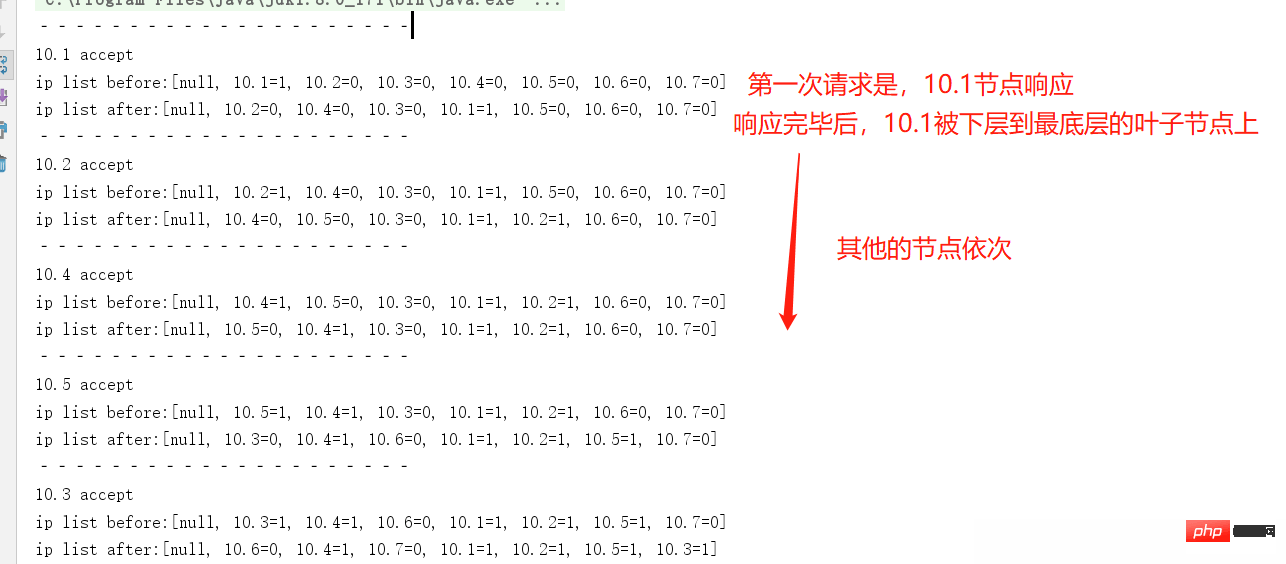
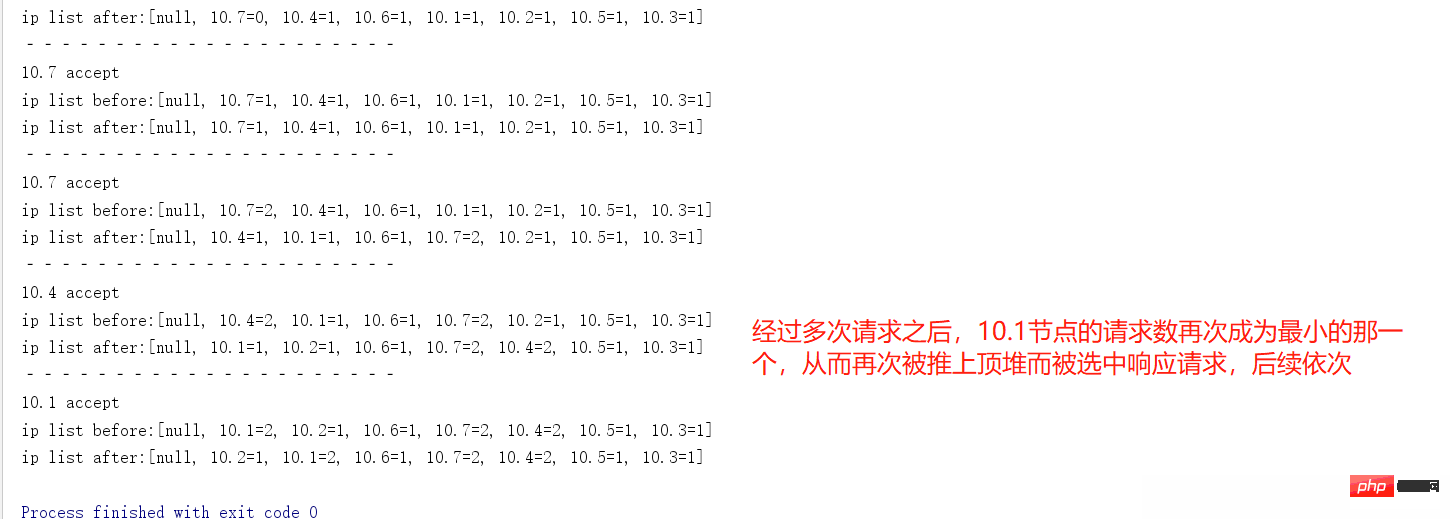
以上是Java負載平衡演算法的作用是什麼?的詳細內容。更多資訊請關注PHP中文網其他相關文章!

